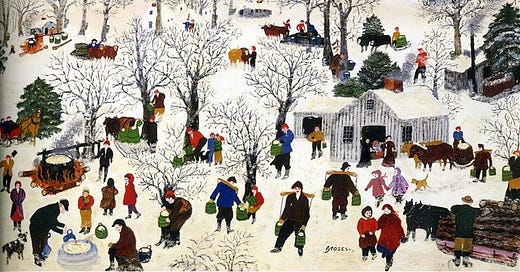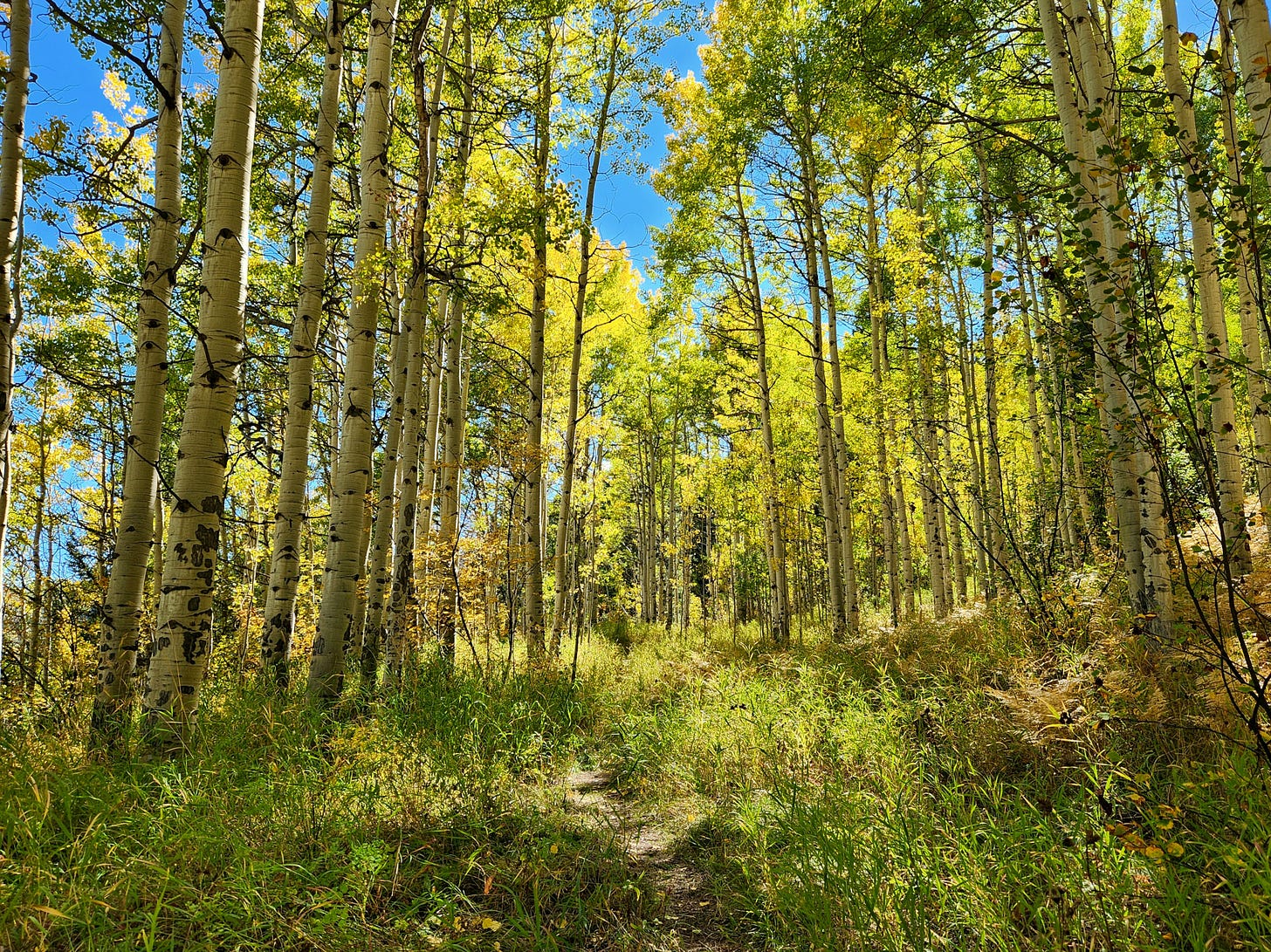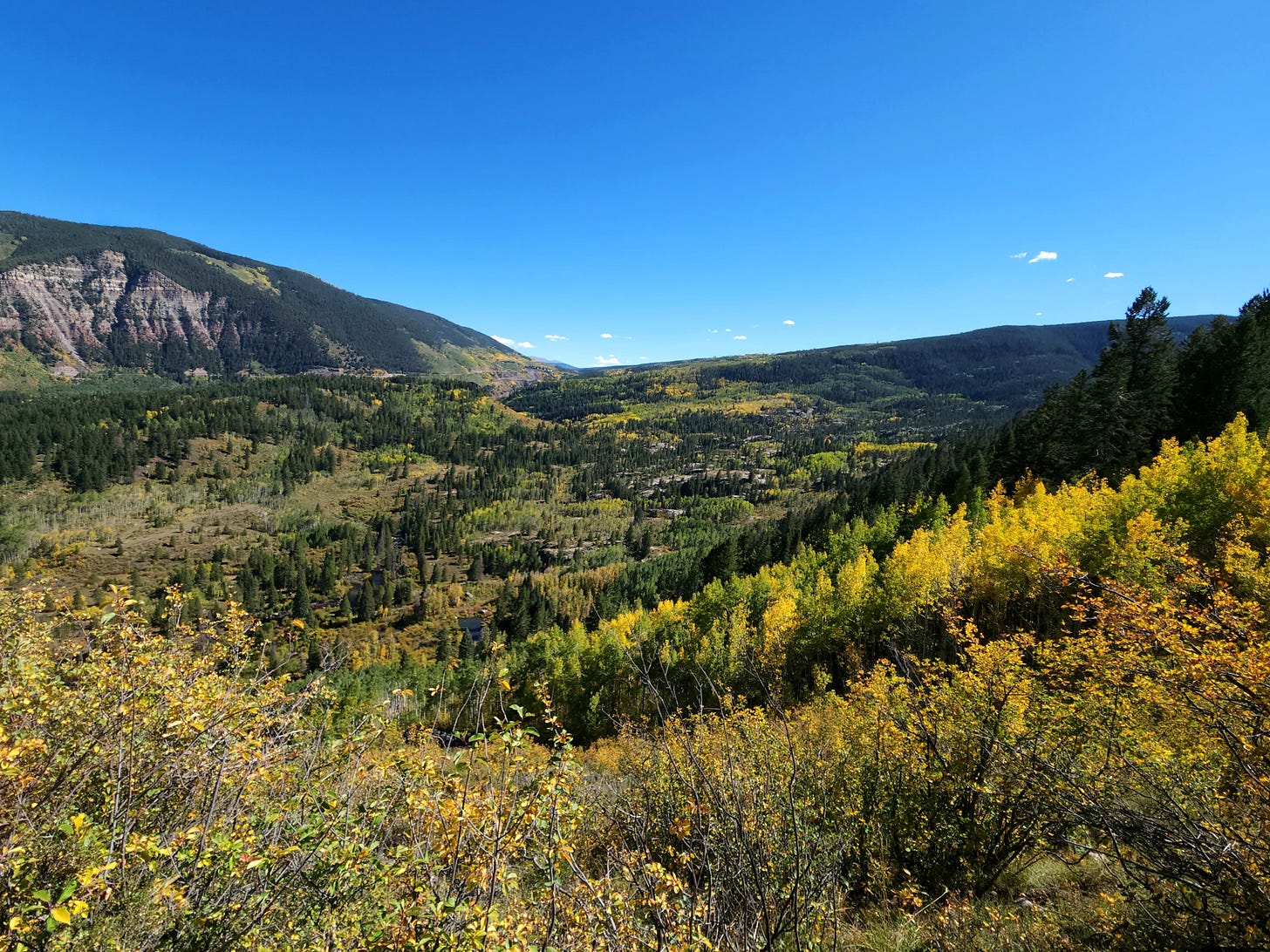Souls Like Wheels is a free weekly newsletter about art and the outdoors, featuring all things creative, adventurous, and quirky.
Love what you’re reading? Subscribe to receive content every week and consider supporting it with a $5 one-time donation.
The Leaf Peepers Emerge
Are the leaves changing in your neck of the woods?
Most of the US will be seeing their forests reach their peak Fall colors in the next few weeks. The leaf peepers will be out in full force photographing as many trees as they can!
I went for a short hike yesterday afternoon near Vail and the Aspen trees are definitely starting to change colors:
Not sure when your area will reach it’s peak?
Check out the Fall Foliage Prediction Map created by Smoky Mountains travel site. They’ve created an interactive map that predicts the various stages of color for the US. Adjust the slider below the map to different weekend dates to see their foliage prediction.
This is how fall is shaping up as of September 26th:

I’d say this map is pretty spot on with their “partial” forecast for my location. Here’s a photo I took yesterday in Minturn, CO:
Get to Know American Folk Art
What is American Folk Art?
Folk art is notoriously difficult to define. (Yes, I know that’s not a strong opening statement, but this fact is just too true to avoid.) It spans so many different mediums from painting to metalworking to stained glass. On top of that, folk art is also categorized more so on the artists’ background and intent rather than the technical aspects that many other genres are based on.
I’ll do my best to sum it up in just a few bullet points. American Folk Art is typically:
Made by working class people
Self-taught
Utilitarian or decorative
Outside of mainstream trends
Reflective of their community, traditions, and social issues.
American folk art is made by everyday folks, the working class, us. Worldwide, folk art is typically defined as art from indigenous peoples, tribes, or the working class. And while folk artists have certainly become famous from their work, they likely didn’t start out rich and famous.
American folk art is largely self-taught. Folk artists do not typically have formal educations in fine art; rather, they developed their skills on their own, learning over time and through personal experience.
Because American folk art lives outside academic influences, the art doesn’t adhere to many artistic “rules” or theories. The artists are more likely to utilize non-traditional tools and skills to achieve their desired goals.
Fork is more decorative and utilitarian than fine art. I think this is easiest to explain with examples: think of weathervanes, furniture, weavings, quilts, and even duck decoys — they’re functional items that are also known for their unique decorations and craftmanship.
American folk art lives outside the mainstream. This genre is commonly referred to as “Outsider Art”. Folk artists are bucking current trends and using whatever style fits their artistic vision — whether or not is it currently popular.
Folk art is heavily influenced by tradition and local culture. While the artists may be expressing themselves individually, their work typically reflects upon their culture including their traditions and the social issues of the time.
“Folk art allows us to appreciate the art and the message rather than admire the artist because they are famous or their work sells for a lot of money. Folk arts connect us with community issues and inspire us to express ourselves artistically.” - Rhian Kivits
Famous American Folk Art
Grandma Moses
Known as one of the most famous American Folk Artists, Anna Mary Robertson started her art career at age 77 to “to keep busy and out of mischief” after her husband passed. Most of her paintings depict rural landscapes and farm life.
The story goes that she displayed her art locally in Hoosick Falls, New York until an art collector passing through town noticed her work and bought it all. Her highest selling work “Sugaring Off” sold in 2006 for $1.2 million.
Read Grandma Moses’ full bio and view more of her works HERE
Leonard Knight
Salvation Mountain is quite literally what you see in the photo above: a manmade mountain built with adobe clay as well as discarded and donated items and covered in millions of gallons of paint. Leonard built the mountain largely by himself and it is now cared for by a non-profit dedicated to preserving his vision.
The structure is located in Niland, CA — near the Salton Sea. You can still visit! Learn more HERE and watch a walking tour of Salvation Mountain HERE
Learn more about American Folk Art
Learn from the American Folk Art Museum and check out their latest collections
Read how Folk Art tells the story of America
Check out Americana Insights an online journal that spotlights traditional American folk art from Colonial times to the early 20th century
Did you know Folk Art Schools are making a comeback? Learn traditional crafts and skills in a creative environment. Find a full of of US schools HERE
Interested in buying modern American Folk Art? Visit your local craft fairs, community art galleries, and even Farmer’s Markets. Folk Art is as “down home” as it gets!
Let’s Chat:
How vibrant are the trees in your area? Let me know in the comments and share your fall photos!
What’s your favorite Fall outdoor activity? Right now I’m loving cool-weather hikes and wearing sweaters every day.
What’s your take of American Folk Art? Who are your favorite artists and what crafts are you most interested in?
What next?
☕ Like what you’re reading? Buy me a coffee to support this free weekly publication. In return, you’ll get more frequent newsletters and fewer typos!
🎨 Are you an artist whose work is intrinsically connected to spending time in nature? Contact me HERE to be featured in this newsletter and reach new audiences.
📸 Follow me on Instagram for daily updates and fun photos.
📖 Read previous newsletters HERE








The foliage map is saying that my area is at peak right now, but I think they got ahead of themselves. The only trees that have turned so far are the ones that suffered during our very hot, dry summer. I think we usually reach peak foliage in late October. I want the trees to hold onto their leaves as long as possible before the gray days of winter.
I love that Grandma Moses winter scene painting. I'm originally from New York and I remember seeing some folk art in some local galleries and art shops.